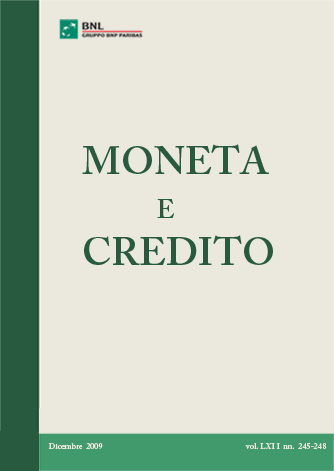L'aumento dei prezzi delle attività e della politica monetaria (The increase in asset prices and monetary policy)
DOI:
https://doi.org/10.13133/2037-3651/9535Parole chiave:
inflazione, asset, GiapponeAbstract
L’inflazione degli asset, a differenza dell’inflazione ordinaria, che si riferisce a l'aumento dei prezzi dei beni di consumo, merci all'ingrosso, o il deflatore del reddito nazionale, è un termine che non è in uso in occidente, ma corrente in Giappone. Ci sono momenti in cui gli assets aumenteranno di prezzo in modo inflazionistico, un boom o anche una bolla, mentre i prezzi dell’output sono relativamente stabili o addirittura in calo.
Asset inflation, as distinguished from ordinary inflation, the latter referring to rising prices of consumer goods, wholesale commodities, or the national-income deflator, is a phrase not in use in the west, but current in Japan. There are times when assets rise in price in an inflationary way, a boom or even a bubble, while output prices are relatively stable or even declining.
JEL Codes: F3, G1, N1, B5
Riferimenti bibliografici
AKERLOF GEORGE A., ROMER PAUL M. (1993), "Looting: the economic underworld of bankruptcy for profit",Brookings Papers on Economic Activity, reprinted in National Bureau ‘of Economic Research, Reprint no. 1868, pp. 1-73.
BANK FOR INTERNATIONAL SETTLEMENTS (1986), Recent Innovations in International Banking, prepared by a Study Group, Sam Y. Cross, Federal Reserve Bank of New York, Chairman, established by the Central Banks of the Group of Ten Countries, Basle.
BANK FOR INTERNATIONAL SETTLEMENTS (1991), Annual Report, Basle.
BANK FOR INTERNATIONAL SETTLEMENTS (1992), Annual Report, Basle.
BANK FOR INTERNATIONAL SETTLEMENTS (1993), Annual Report, Basle.
BANK FOR INTERNATIONAL SETTLEMENTS (1994), Annual Report, Basle.
BORIO C.E.V., KENNEDY N., PROWSE S.D. (1994), "Exploring aggregate price fluctuations across countries: measurement, determinants and monetary policy implications", BIS Economic Papers, no. 40, April, pp. 1-101.
CAMPBELL JOHN Y. (1994), "Asset pricing", NBER Reporter, Program Report, Spring, pp. 1-4.
CAMPBELL JOHN Y. (1994), "The New Palgrave Dictionary of Money and Finance", Journal of Economic Literature,vol.32, n. 2, pp. 667-73.
CAMPBELL JOHN Y. (1994), "What moves the stock market?", NBER Reporter, Research Summaries, Fall, pp. 8-10.
CASE K.E., SHILLER R. (1986), "The behavior of home buyers in boom and post-boom markets", New England Economic Review, November-December, pp. 29-46.
CHANDLER L.V. (1956), Benjamin Strong, Central Banker, Brookings Institution, Washington. The Economist(1994), vol. 332, no. 7877, August 20.
FRIEDMAN M., JACOBSON SCHWARTZ A. (1963), A Monetary History of the United States, 1867-1960, Princeton University Press, Princeton.
INTERNATIONAL MONETARY FUND (1992), International Financial Statistics, Washington.
HOYT H. (1933), One Hundred Years of Land Values in Chicago: The Relationship of the Growth of Chicago to the Rise of Its Land Values, 1830-1933, University of Chicago Press, Chicago.
JAMES B. (1994), "International monetary cooperation since Bretton Woods", draft manuscript, October.
KEITZAI KOHO CENTER (1994), Japan, 1994: An International Comparison, Tokyo.
KEYNES J.M. (1930), A Treatise on Money, 2 vols., Harcourt, Brace, New York.
KEYNES J.M. (1936), The General Theory of Employment, Interest and Money, Harcourt, Brace, New York.
KINDLEBERGER C.P. (1986), The World in Depression, 1929-1939, revised edition, University of California Press, Berkeley.
KINDLEBERGER C.P. (1989), Manias, Panics and Crashes: A History of Financial Crises, 2nd edition, Basic Books, New York.
KINDLEBERGER C.P. (1991), "International (and interregional) aspects of financial crises", in Martin Feldstein ed.,The Risk of Economic Crisis, pp. 128-32, University of Chicago Press, Chicago.
KINDLEBERGER C.P. (1992), Mariners and Markets, Harvester/Wheatsheaf, New York.
KINDLEBERGER C.P. (1993), A Financial History of Western Europe, 2nd edition, Oxford University Press, New York.
KORTY RESEARCH (l994), Investment Direction, October.
MCKINNON R.L (1973), Money and Capital in Economic Development, Brookings Institution, Washington.
MCKINNON R.L. (1994), The Order of Economic Liberalization: Financial Control in the Transition to a Market Economy, 2nd edition, Johns Hopkins Press, Baltimore.
MUNDELL R.A., SWOBODA A.K. eds. (1969), Monetary Problems of the International Economy, University of Chicago Press, Chicago.
NBER,Reporter, various issues, Cambridge, Mass.
REED M.C. (1975), Investment in Railways in Britain: A Study in the Development of the Capital Market, Oxford University Press, London.
SELGIN G. (1986), The Theory of Free Banking, Rowan and Littlefield, Totowa.
SHAW EDWARD S. (1973), Financial Deepening in Economic Development, Oxford University Press, New York.
SMITH G.D., SYLLA R. (1993), "The transformation of financial capitalism: an essay on the history of American capital markets", Financial Markets, Institutions and Instruments, vol. 2, n. 2, pp. 1-62.
SMOLER F. (1994), "A view from the Fed: an interview with Paul A. Volcker", Audacity, vol.3, n. 1, Fall, pp. 6-15.
SUMMERS LAWRENCE H. (1985), "On economics and finance", Journal of Finance, vol. 11, n. 3, July, pp. 633-65.
TINBERGEN J. (1965), On the Theory of Economic Policy, 2nd edition, North Holland, Amsterdam.
VAN HORNE J.C. (1985), "Financial innovation and excesses", Journal of Finance, vol. 11, n. 3, July, pp. 621-31.
VOLCKER P.A., GYOHTEN T. (1992), Changing Fortunes: The World’s Money and the Threat to American Leadership, Times Books, New York.
##submission.downloads##
Pubblicato
Fascicolo
Sezione
Licenza

Ogni materiale pubblicato sul sito e gli articoli pubblicati sulla rivista sono distribuiti con Licenza internazionale Creative Commons Attribuzione - Non commerciale - Non opere derivate 4.0. Copia della licenza è disponibile alla URL http://creativecommons.org/licenses/by-nc-nd/4.0. Gli autori mantengono i diritti sulla loro opera e cedono alla rivista il diritto di prima pubblicazione dell'opera con la licenza suindicata.


